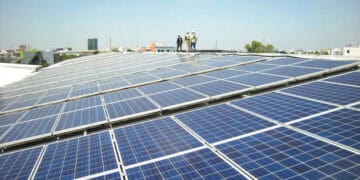The solar industry is advocating for adjustments to the current tariff structure concerning the importation of silicon cells, aiming to address evolving market dynamics. Currently, traditional monofacial solar panels brought into the country are subject to a tariff of 14.5% until Feb. 6, 2024. This rate is set to gradually decrease by 0.25% annually until it reaches 14% by Feb. 6, 2026. Notably, bifacial solar panels are exempt from these tariffs, as are the first 5 GW of imported silicon solar cells to the United States.
Today’s hearing aimed to evaluate the effectiveness of these tariffs in fulfilling their initial objective of supporting domestic solar panel manufacturing and preventing the influx of inexpensive solar panels from other countries.
Representatives from various industry stakeholders participated in the hearing, including the Solar Energy Industries Association (SEIA), U.S. silicon cell and panel manufacturers such as Qcells, Canadian Solar, Silfab Solar, Heliene, Suniva, and thin-film panel maker First Solar.
While First Solar and Suniva expressed satisfaction with the current safeguard measures and advocated for no changes, SEIA, Qcells, Canadian Solar, Silfab, and Heliene proposed significant adjustments to the tariff rate quota (TRQ) on imported cells.
Recent Developments and Industry Response
Since the initiation of the four-year Section 201 safeguard in February 2022, several developments have occurred within the industry. Manufacturers such as LG Electronics have ceased solar panel production, while others like Qcells are expanding their manufacturing facilities. Additionally, the Inflation Reduction Act (IRA), passed in August 2022, has provided substantial incentives to solar installers and manufacturers, contributing to increased domestic manufacturing activity.
Qcells highlighted the positive impact of the Section 201 tariffs on the domestic solar module industry, attributing job creation and investments in manufacturing to these measures. However, Qcells also noted that the existing TRQ for duty-free cells may soon be inadequate to meet the demands of the expanding U.S. manufacturing market, necessitating a revision.
Calls for Change
Other industry players, including Canadian Solar, Silfab, and Heliene, urged for an increase in the TRQ to 20 GW or the complete removal of tariffs on imported cells, arguing that the current TRQ serves no purpose and could hinder industry growth.
SEIA echoed these sentiments, emphasizing the importance of providing the domestic industry with access to imported cells to support growth and innovation. On the contrary, First Solar expressed dissatisfaction with the exemption of bifacial panels from tariffs but acknowledged the overall effectiveness of the safeguard remedy in supporting domestic industry efforts.
Looking Ahead
The U.S. International Trade Commission (ITC) will release an official midterm report on the tariffs in February 2024, following which any legal changes to the tariffs would require action from the president and Congress. The outcome of this evaluation will have significant implications for the solar industry and its stakeholders, shaping the future trajectory of solar panel manufacturing and trade in the United States.
Stay informed with supply chain news on The Supply Chain Report. Free tools for international trade are at ADAMftd.com.
#SolarIndustry #TariffReform #SiliconCells #MonofacialPanels #BifacialPanels #SEIA #Qcells #CanadianSolar #SilfabSolar #Heliene #Suniva #FirstSolar #SolarTariffs #USManufacturing #InflationReductionAct #SolarManufacturing #TariffQuota #CleanEnergy #USolarGrowth #SolarPanels #RenewableEnergy

















